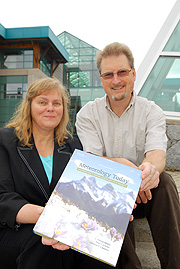UNBC Faculty Publish First Canadian Weather Textbook
August 17, 2011
|
Growing frustration with American textbooks among Canadian students and instructors has led a husband and wife team at the University of Northern British Columbia to produce the first-ever weather textbook specifically aimed at Canadian students. UNBC Environmental Science Professor Peter Jackson and spouse Chris, a Geography Senior Lab Instructor, have adapted a popular US textbook to address concerns that Canadian weather systems and methods are underrepresented and misunderstood. |
Media Downloads Click on a thumbnail to access a high resolution image. |
